On the northern wall of the Sala del Mappamondo in Siena ’s Palazzo Pubblico stretches for 110 square meters one of the masterpieces of Sienese painting, created, presumably starting in 1312, by Simone Martini (Siena, c. 1284 - Avignon, 1344). This is the Majesty, a work commissioned to the Sienese painter by the Government of the Nine, an expression of the great merchants, bankers and big businessmen of the city, who remained in power from 1287 to 1355. In the room in which the Sienese territorial conquests were painted through the representation of the subjugated castles, a precise religious subject was chosen to be depicted that was well present in the collective imagination in Siena, since the splendid Maestà by Duccio di Buoninsegna (Siena, 1255 - 1318/1319) had been present on the high altar of the Duomo since 1311. Same subject, but two achievements with quite different motivations and intentions. If Duccio’s panel is an exquisite neo-Byzantine icon of pure devotion to the Virgin, and depicts a situation that does not belong to this world, in Martini’s work one can immediately grasp the more profane intention and the desire to seek direct contact with the viewer, engaging him in an engaging way. In fact, this depiction accompanied by precise vernacular inscriptions composed by a poet up to date with the linguistic innovations of Dante’s Commedia was entrusted with an ethical-political message that had to be clearly understandable to those gathered in that hall during the General Council.
It must be remembered that the city had vowed to the Virgin at the Battle of Montaperti on September 4, 1260, won by the Ghibelline army, whose Sienese contingent was led by Provenzano Salvani, against Guelph Florence.
“Those who entered the room were not confronted with the fixed image of a distant, unattainable paradise, such as one might have seen illustrated on an altar table, but almost to the representation of an event, albeit an exceptional one, to the real representation of a court scene”: so writes art historian Alessandro Bagnoli in the volume published following the major restoration in the 1990s, of which he was the director. That was the occasion to formulate unpublished observations that contributed to an in-depth understanding of several aspects hitherto unclear or not considered at all, showing how restoration is an incredible and fundamental cognitive moment of a work of art.
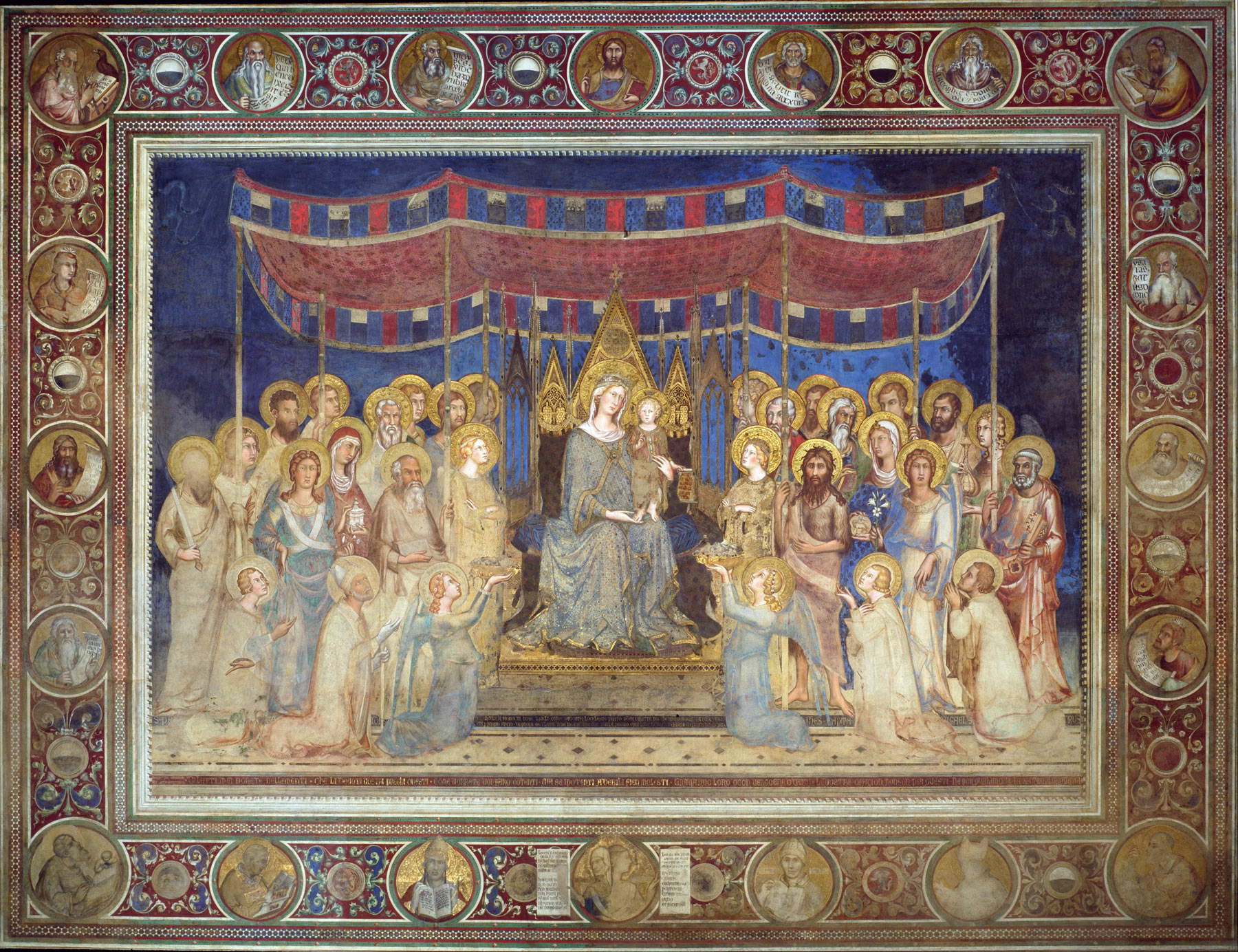 |
| Simone Martini, Majesty (1312-1315; fresco and applications of various materialsî, 763 x 970 cm; Siena, Palazzo Pubblico) |
 |
| Palazzo Pubblico, the wall of the Sala del Mappamondo that houses Simone Martini’s Majesty |
One should not fall into the mistake of considering the work only for the part in which the Virgin and Child, archangels, angels and saints are depicted. In fact, the Majesty was conceived in a unified manner from the frame at the top to the flounce decorated with faux marble at the bottom.
In the medallions of the frame one can recognize the blessing Savior (top, center), patriarchs and prophets (top and on the sides), evangelists (in the corners), and doctors of the Church (bottom); in addition, in the lower area in a central position, there is a two-headed figure representing the Lex Vetus and the Lex Nova (on the stone tablets that the figure holds are in fact the Ten Commandments and the Seven Sacraments). We can then recognize many symbols of Siena: the city seal, the seal of the Captain of the People, the coin, the Sienese she-wolf, the Sienese Balzana (black and white), and the rampant lion of the people. Also included in the decoration of the canopy are the coats of arms of the Anjou and the royal house of France, as well as those of the city, indicating the Guelph faith of the Siena of the Nine and its alliances.
The Virgin and Child seated on a throne appears as a queen of the era, and at her sides finds space for her heavenly court made up of saints, archangels and angels. Kneeling before the throne are two angels offering basins of flowers (with an attitude reminiscent of Giotto’s in the Majesty of All Saints) and the four patron saints of the city of Siena: saint Ansanus, saint Savinus, saint Crescentius, and saint Victor.
This depiction is set within a frame conceived with great architectural illusionism, so much so that it gives the impression of the tangible thickness of the embossed wall beyond which the scene unfolds. The point of view of the composition is centralized. The Giotto-inspired architectural corbels that characterize the frame converge toward the center, and the central one is shown perfectly frontal.
The large canopy gives a strong sense of depth to the depiction, demonstrating great consistency with Giotto’s rationality. On the poles Simone depicts small foreshortened heraldic coats of arms to restore the sense of roundness. The drapery falls in a casual manner. In this reworking of Giottesque illusionism, a place of honor is occupied by the large marble-mirrored flounce painted in the lower part of the wall, which sees Giotto of Padua and of the Magdalene Chapel in Assisi as references.
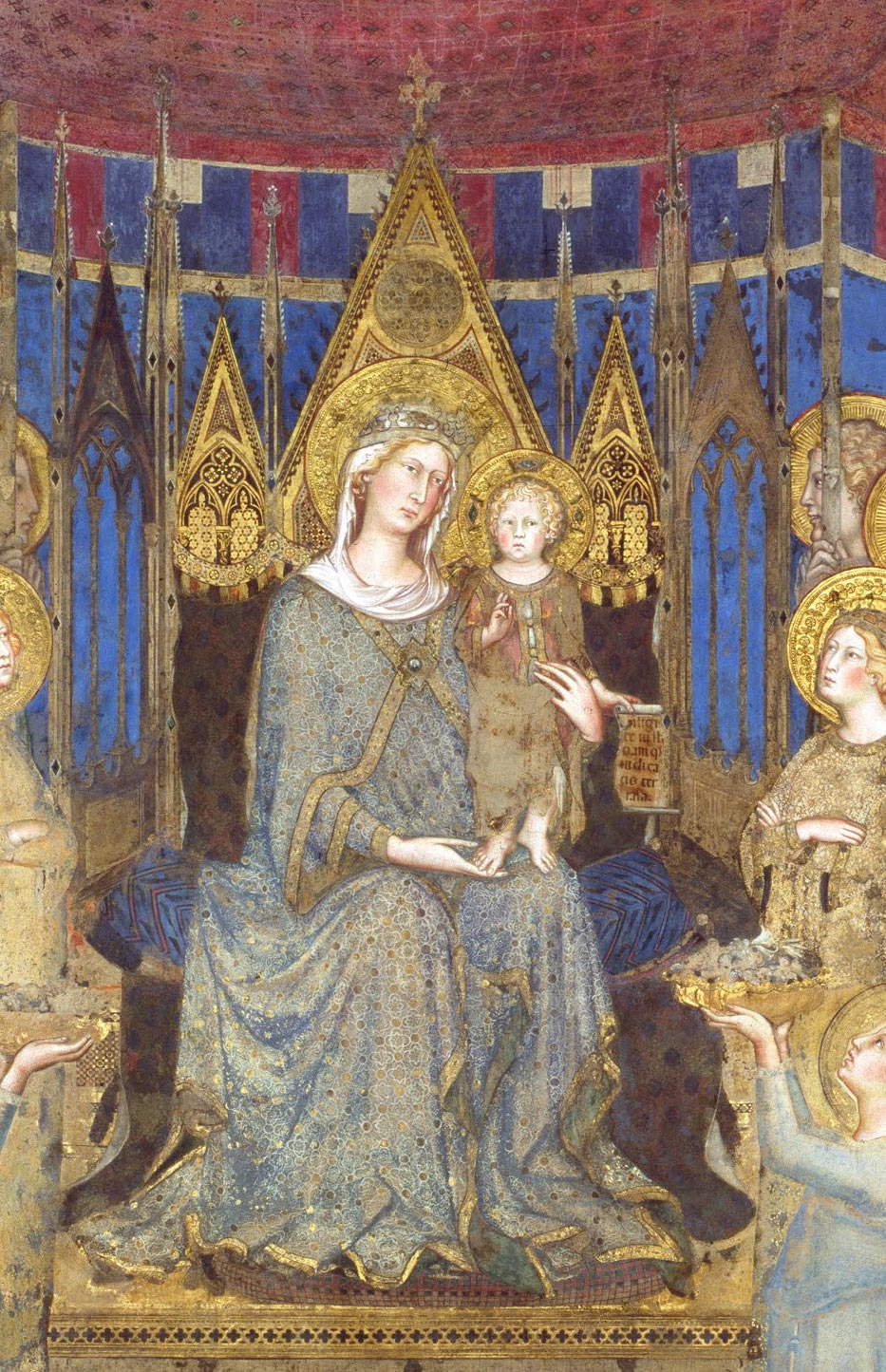 |
| The Virgin and Child |
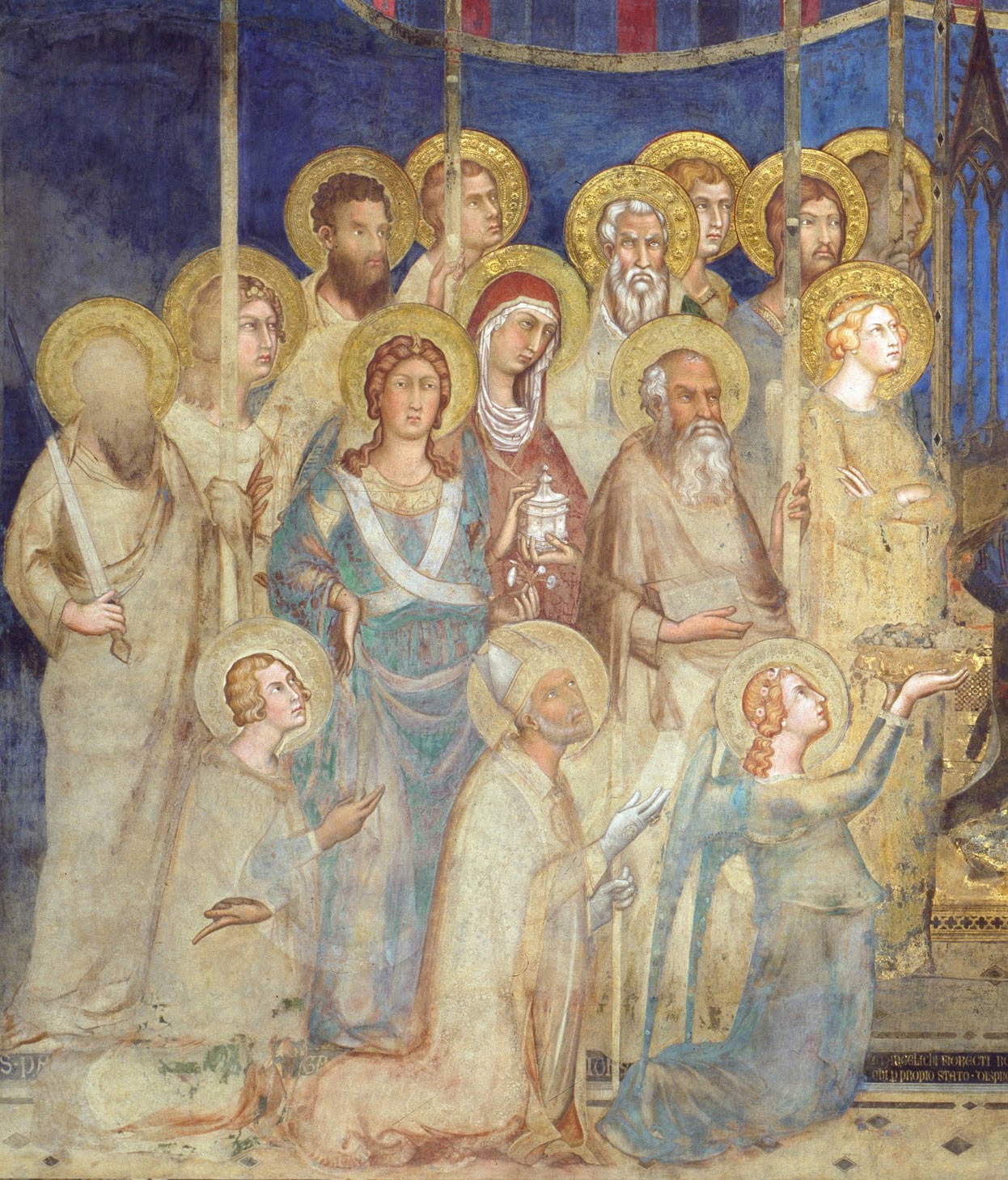 |
| The group of angels and saints to the right of the Virgin. Starting from the bottom, first row: saint Ansanus, saint Savinus, an angel. Second row: saint Paul, saint Michael the archangel, saint John the Evangelist. Third row: archangel Uriel, saint Mary Magdalene, saint Ursula. Fourth row: saint Bartholomew, saint Matthew, saint James the Lesser. |
 |
| The group of angels and saints to the left of the Virgin. Starting from the bottom, first row: an angel, Saint Crescentius, Saint Victor. Second row: saint John the Baptist, saint Gabriel the archangel, saint Peter. Third row: saint Catherine, saint Agnes, saint Raphael the archangel. Fourth row: saint James the Greater, saint Andrew, saint Simon. |
 |
| The blessing Savior |
 |
| Lex nova and lex vetus |
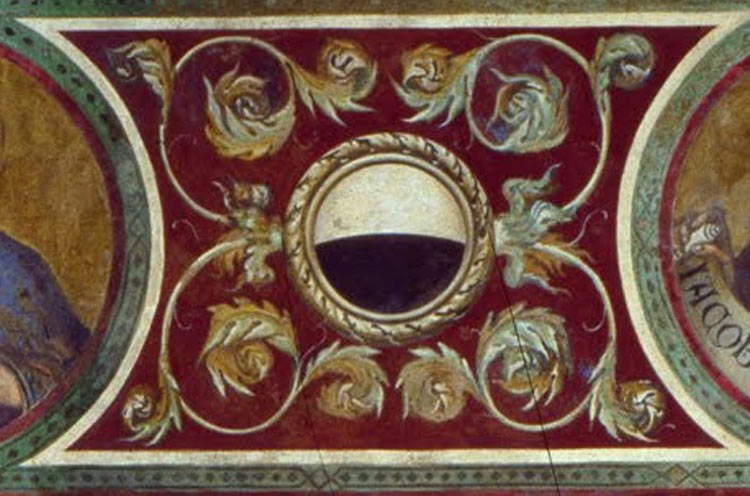 |
| The Sienese balzana |
 |
| Saint Ansanus and Saint Savinus |
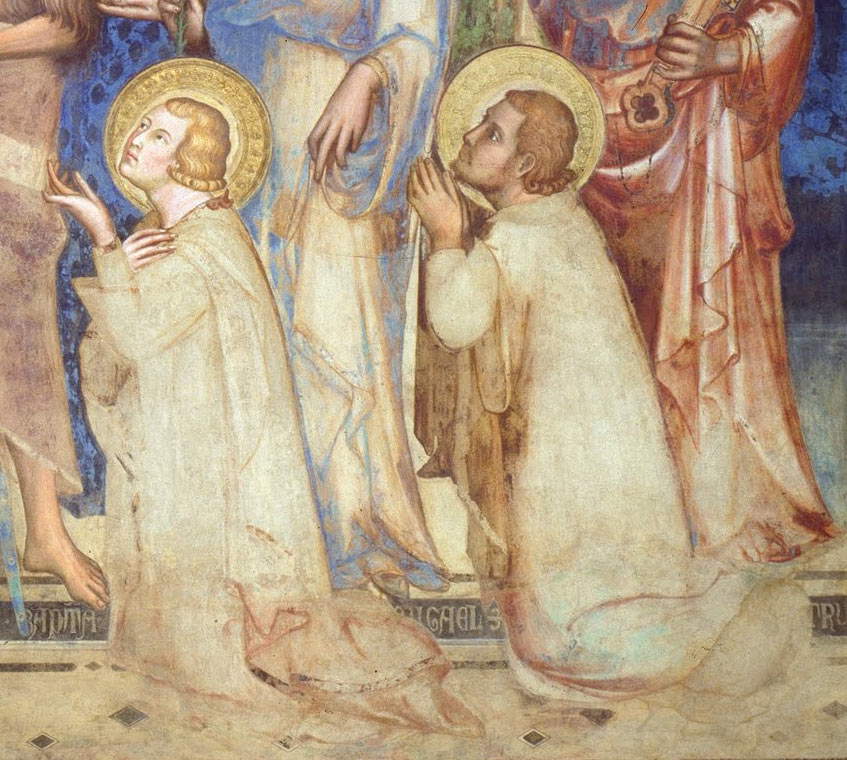 |
| Saint Crescentius and Saint Victor |
 |
| The baldachin |
The light is designed to come from the right, just where the openings within the room are physically located.
The arrangement of the figures within the space and the solidity of their volumes also demonstrate Simone’s Giottesque awareness. Some of these sacred figures are even depicted behind the poles of the canopy and at times they ’impale’ each other, thus showing an unprecedented spatial freedom. The faces are depicted frontally, in profile or three-quarter view, and there is a play of gazes and relationships between them. It is precisely by observing some of these faces that one grasps the homage to the figurative culture until then predominant in the panorama of painting in Siena, that of Duccio. Duccio’s stylistic features are well discernible in faces such as those of Magdalene and Saint Agnes or in those of the archangels Gabriel and Michael. These faces give other splendid details: in the face depicted behind the pole of the canopy, on the right, a smile unfolds and teeth can be glimpsed. Here again Simone picks up on Giottesque experimentation, echoing the Child’s smile in the tondo on the counter-façade in the Upper Basilica in Assisi.
Simone Martini’s desire in this work is to create a credible representation that succeeds in capturing the various aspects of the reality of things. To achieve this, he does not limit himself to new formal solutions, but finds expedients that are unprecedented (at least in Italy) for mural painting. In fact, the surface is revealed to be decorated not only through traditional pictorial drafting, but also through the inclusion of materials and techniques not usual for mural painting.
The Virgin and Child is seated on a throne that recalls the forms of transalpine Gothic architecture, elaborating a design beyond any contemporary architectural achievement in Italy. This throne looks like a large architectural reliquary, updated on the goldsmith productions of the time. That between Simone and goldsmiths is a close relationship, and this work is a clear example. The painter, in fact, does not merely reproduce models inspired by contemporary goldsmithing through the medium of painting, but makes use of some of the techniques peculiar to suntuary art. One can observe the use of punches in different areas of the surface, such as in the frame and especially in the haloes. In fact, the saints on the right side of the Majesty, the patriarchs, the prophets, St. John and St. Mark have raised and radiated haloes, following the model introduced in Assisi, while starting with St. Ursula Simone uses punches to decorate the surface of the nimbuses, making them elaborate and precious. Sienese goldsmiths represented an outpost for the spread of the transmontane ’Gothic way’ in Italy, beginning with Guccio di Mannaia. The frame medallions at the top, with a marked design, incisive lines creating beards and hair moved by leonine characters, find fruitful comparison with the figurines Guccio had depicted in the chalice for Pope Nicholas IV. At the time of the Maestà’s execution, goldsmiths such as Tondino di Guerrino, Andrea Riguardi, and Duccio di Donato were still bearers of that figurative culture in Siena.
With a view to achieving a naturalistic mimesis of the work, Simone decided not to limit himself to imitating reality through the medium of painting, but to insert within the painting the real materials he was supposed to represent. Thus for the Virgin’s clasp Simone uses a real cabochon rock crystal anchored to the wall by means of a metal box, for the Child’s scroll he uses a real sheet of paper, in the structure of the throne he inserts glass églomisés, and to make St. Paul’s sword he applies a metal foil (now lost). The precedents for this polymaterism are to be found in some episodes of the artistic tradition beyond the Alps.
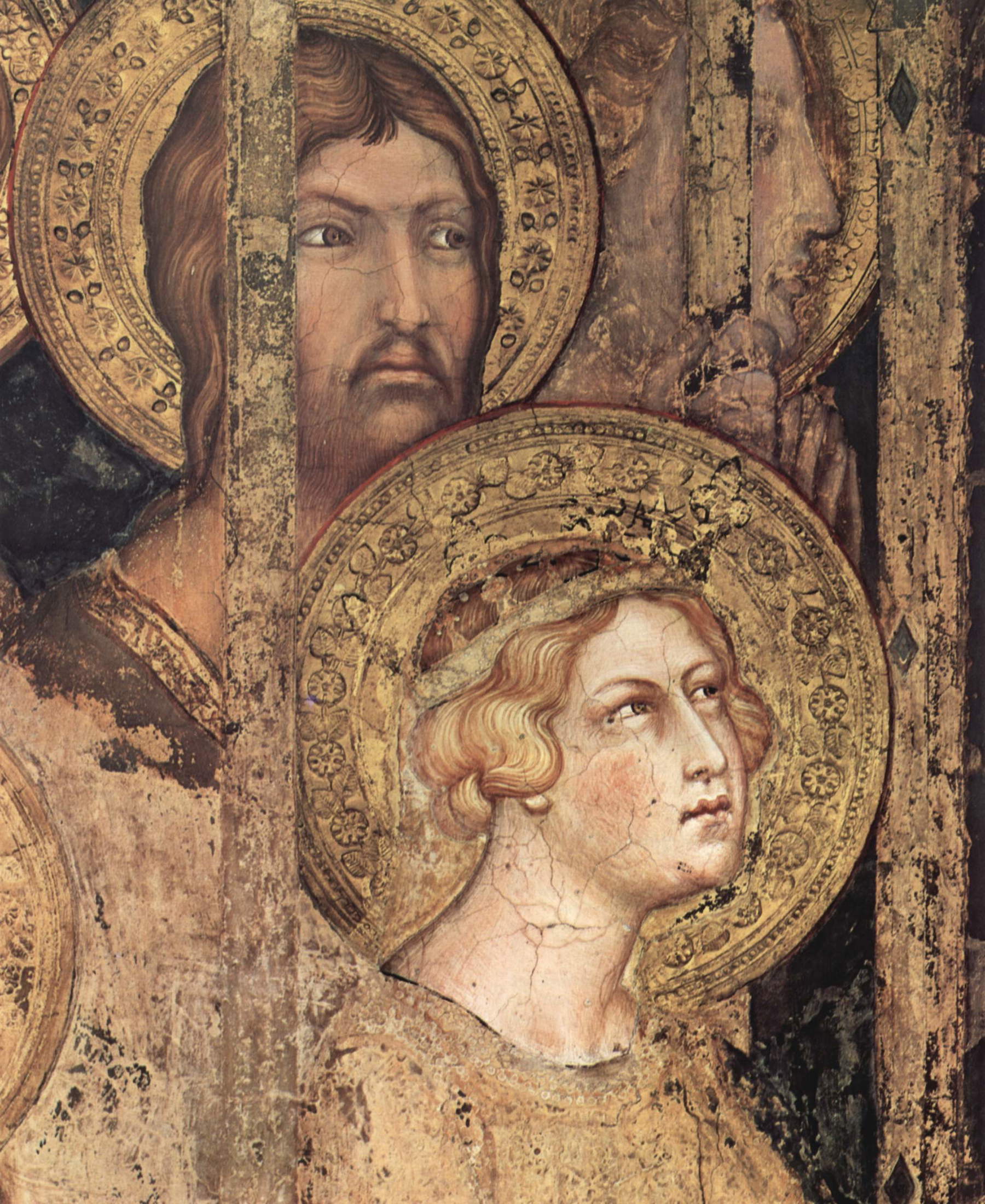 |
| Saint Ursula |
 |
| Comparison between Simone Martini’s Saint Agnes and the Saint Agnes of Duccio di Buoninsegna’s Maestà |
 |
| The Child holding the scroll |
 |
| Saint Paul |
 |
| Guccio di Mannaia, St. Paul, detail from the chalice of Nicholas IV (Assisi; Museum of the Treasury of the Basilica of St. Francis) |
Even through the medium of painting he achieves results of great naturalism. In St. Peter, the desire to pursue the real leads Simone to paint the regrowth on the saint’s head. St. Thaddeus, on the other hand, is depicted with blue irises: we are dealing with one of the first cases of cerulean eyes in Italian painting.
Thanks to an inscription we know the end of the work on the Majesty: THOUSAND THIRTY FIFTEEN VOL<GEA>/ E DELIA AVEA OGNI BEL FIORE SPINTO/ E IUNIO GIÀ GRIDAVA: “I MI RIVOL<LO>,” to be interpreted as indicating mid-June 1315. However, the work was not executed continuously, and an interval of time must be identified during which Simone stopped working in the Sala del Mappamondo. Indeed, one can detect at the height of the thighs of the kneeling angels and patron saints a break in the plasterwork. In addition to this physical fact, it is the observation of stylistic features that confirms that something happened in Simone’s path. In the lower area of the painting, in fact, the painting becomes softer, more suffused than the chromatic mixtures and drafts of the upper area. Take, for example, the depiction of some of the plant elements in the frame: those in the upper part give back to the eye an almost metallic feeling, while those in the lower area are of an incredible naturalistic accuracy, especially we seem to be able to perceive the softness of the flowers of the wild thistles. There are also important innovations in the management of space. In the roundels depicting the doctors of the Church, the figures do not remain within the limit of their own frame, as is the case with the figures in the upper tier, but take the freedom to step out, to occupy the ’space beyond.’ For example, St. Gregory’s tiara comes out of the limit of the roundel as do the bookmark and book cover clips resting on the frame. The feeling is that of observing a figure looking out of a porthole. What is the reason for this stylistic change? The answer is once again to be found in the Assisi building site. In fact, while working on the Maestà, Simone received, from Cardinal Gentile Partino da Montefiore, the prestigious commission to decorate the chapel of San Martino in the Lower Basilica. In this way the Sienese painter confronted the more modern outcomes of Giotto’s painting, elaborating them already in the Assisian chapel. Returning to Siena, he brought back the new ideas in the completion of the Maestà.
 |
| Saint Peter |
 |
| Saint Gregory |
 |
| Giotto, St. Francis Appears to Gregory IX (ca. 1295-1299; fresco, 230 x 270 cm; Assisi, Upper Basilica of St. Francis) |
The ethical-political message entrusted to this depiction is made explicit through a set of inscriptions. In the painted strip simulating porphyry we read, "Responsio Virginis ad dicta santorum / Beloveds of mine, place in the minds / that the devout your honest prayers / as you will I will make happy. / But if the powerful to ’debil’ fien molest, / burdening them either with shame or harm, / your prayers are not for these/ nor for whatever my land deceives."
It is in these words of the Virgin that lies the heart of the message. Indeed, it is an exhortation to good governance, to the proper administration of justice through the observance of existing laws. This relates to the Child’s scroll, in that it contains the words attributed to the wise and just King Solomon in the opening of the Book of Wisdom "Diligite iustitiam qui iudicatis terram." The Virgin’s declaration also appears as a self-legitimization of the Government of the Nine and a defense against the pitfalls that ran in the city against that administration.
The other inscription, in Gothic capitals in gold leaf on a black background, which runs on the step between the two kneeling angels, is also spoken by the Virgin: “Li angelichi fiorecti, rose e gigli, / onde s’adorna lo celeste prato, / non mi dilettan più che i buon consigli. / But sometimes I see those who by their own state / despise me and my land deceive, / and when they speak worse they are more praised. / Look at each one whose this dir[n]na condemns!”
This inscription dates back to 1321, when Simone Martini was asked to intervene again on his Majesty. The motivation for this ’raconciatura’ is to be found in the commissioner’s need to reinforce its message. In 1318, in fact, one of the most insidious events for its stability in the history of the Novesque government took place, known as the ’revolt of the carnaioli,’ the owners of cattle farms and meat merchants, but which also involved other powerful categories, such as judges and notaries, and magnate families: all of these individuals were united by their exclusion from being able to access government office. The conspiracy fails. These new verses, composed of seven endecasyllables in rhymed vernacular, contain an important concept, that of the subordination of private interest to the common interest. It is a very clear and powerful new message. The Virgin likes the flowers offered to her by the angels as well as the good advice, or more generally, the honest political action that was being performed before her during the General Council. At the same time she sees that not everyone behaves loyally toward the institutions out of private interest, thus despising her and the land she protects, and the more they act and speak badly the more their approval increases. She concludes by emphasizing to keep well in mind her words condemning those who behave that way. A warning that spans the centuries and still seems absolutely relevant to us.
 |
| First part of the inscription |
 |
| Second part of the inscription |
The inclusion of this new message from Our Lady meant that some stylistic changes also had to be made. The new inscription, in fact, was inserted in place of the dicta sanctorum, which therefore needed a new location. Simone thoughtto add cartouches held in the hands of the patron saints (unfortunately, these elements, made in 1321 in drywall, are no longer legible as the painting has fallen off, thus causing the dialogue with the Virgin to cease). For St. Ansanus, St. Savinus and St. Victor he manages to graft the cartouches into the version finished in 1315, while for St. Crescentius he thinks he needs to make a change. He thus repaints part of the left hand and the right hand. For the sake of stylistic consistency he also repaints the saint’s face. This triggers a chain reaction that also leads to changing the face of St. Ansanus, in the iconography depicted as the twin saint of Crescentius, and for a matter of stylistic homogeneity he changes the faces and hands of the characters in the center of the depiction, which, with the insertion of the new inscription on the throne step, stand out even more: the Virgin, the Child, the offering angels, and the holy princesses Ursula and Catherine. The hand with which St. Paul holds the sword is also repainted. For the changes, Simone intervenes surgically, cutting away the previous plaster and laying a new layer on which to make the new figuration. These are faces with lighter and brighter complexions, colder than those in the rest of the composition, and the lines have become thinner and sharper. The humanity he had previously depicted was becoming more elitist and sophisticated.
Through the reproduction of the seal of the Municipality and that of the Captain of the People, placed on either side of the porphyry strip that contains the temporal term of the Majesty, probably originally accompanied by the indication of the patron, documentary value is given to this work. In the area below is the painter’s signature “S<E L>A MAN DI SYMONE...” in lacunar form. Simone Martini brings together different figurative traditions and develops his own, extraordinary artistic way for this work in which a sacred theme is adapted to the propaganda needs of the Sienese government.
Warning: the translation into English of the original Italian article was created using automatic tools. We undertake to review all articles, but we do not guarantee the total absence of inaccuracies in the translation due to the program. You can find the original by clicking on the ITA button. If you find any mistake,please contact us.